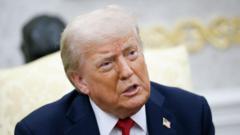Despite facing significant tariffs, China’s economy has shown continued growth driven by strategic investments and adaptive measures.
China's Economic Growth Defies Tariffs: A Closer Look

China's Economic Growth Defies Tariffs: A Closer Look
China's economy demonstrates surprising resilience amid external trade challenges.
China’s economy has surprised analysts by maintaining a steady growth trajectory in the face of tariffs implemented by the Trump administration. Official reports indicate that during the spring months, the economy expanded at an annualized rate of approximately 4.1 percent. This growth can be attributed to ongoing investments in infrastructure, such as high-speed rail projects, and a constant influx of global exports.
In the first quarter of the year, anticipation of tariffs spurred companies to increase their orders, resulting in a positive surge for the economy. Meanwhile, the latest inflation statistics in the U.S. indicated that the tariffs were starting to affect consumer prices, particularly in sectors like household goods, which saw notable price hikes in June.
In an unexpected policy shift, the Trump administration has allowed Chinese tech firms to resume purchasing Nvidia’s A.I. chips, three months after an initial embargo. This development marks a significant reversal as the U.S. navigates its tech relationships with China.
On a related note, the Chinese government has taken steps to limit the export of crucial technologies necessary for manufacturing electric vehicle batteries, which poses potential challenges for Chinese electric carmakers seeking to expand production abroad, particularly in the European market.
Amidst these unfolding dynamics, Australian Prime Minister Anthony Albanese recently traveled to China to bolster bilateral relations, all while balancing pressures from the United States. His dialogues with Chinese leader Xi Jinping highlight the nuanced interplay of international relations and economic strategy in this complex landscape.
In the first quarter of the year, anticipation of tariffs spurred companies to increase their orders, resulting in a positive surge for the economy. Meanwhile, the latest inflation statistics in the U.S. indicated that the tariffs were starting to affect consumer prices, particularly in sectors like household goods, which saw notable price hikes in June.
In an unexpected policy shift, the Trump administration has allowed Chinese tech firms to resume purchasing Nvidia’s A.I. chips, three months after an initial embargo. This development marks a significant reversal as the U.S. navigates its tech relationships with China.
On a related note, the Chinese government has taken steps to limit the export of crucial technologies necessary for manufacturing electric vehicle batteries, which poses potential challenges for Chinese electric carmakers seeking to expand production abroad, particularly in the European market.
Amidst these unfolding dynamics, Australian Prime Minister Anthony Albanese recently traveled to China to bolster bilateral relations, all while balancing pressures from the United States. His dialogues with Chinese leader Xi Jinping highlight the nuanced interplay of international relations and economic strategy in this complex landscape.




















